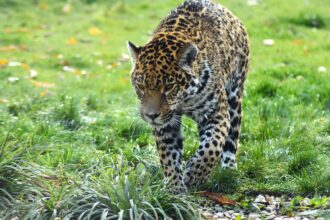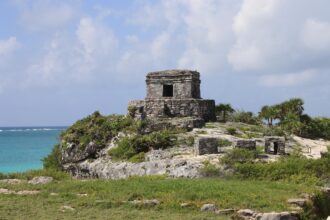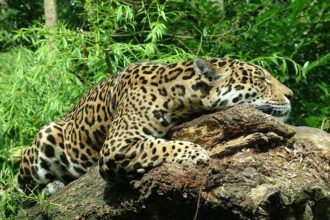The Role of Tulum in the Mesoamerican Biological Corridor for Jaguars
Understanding the Mesoamerican Biological Corridor
The Mesoamerican Biological Corridor (MBC) encompasses a range of ecosystems that extend from northeastern Mexico down to Panama. This vital region acts as a bridge for wildlife, enabling species such as jaguars (Panthera onca) to migrate, breed, and thrive across varied habitats. Protecting this corridor is crucial to maintaining biodiversity and ecosystems that are increasingly threatened by human activity, deforestation, and climate change.
Tulum: A Biodiversity Hotspot
Tulum, located on the Caribbean coast of Mexico’s Yucatán Peninsula, is more than just a tourist destination known for its stunning beaches and ancient Mayan ruins. This region is a key part of the Mesoamerican Biological Corridor, defined by its ecological diversity and rich cultural heritage. The area’s mixed ecosystems—ranging from coastal wetlands to tropical forests—are essential for a multitude of species, especially the iconic jaguar.
Habitat Types in Tulum
Tulum’s geographical features include limestone caves, cenotes (natural sinkholes), coral reefs, and coastal mangroves. These habitats support not only jaguars but also a plethora of other species. The dense forests provide cover and hunting grounds for jaguars, making it essential for their survival. Mangrove swamps, often overlooked, serve as important transitional zones where jaguars can access both marine and terrestrial food sources.
-
Tropical Rainforests: The jungles surrounding Tulum are characterized by dense vegetation and high biodiversity. Here, jaguars find ample prey, from capybaras and deer to smaller mammals and birds. The dense cover also acts as a refuge from human interference.
-
Cenotes: These freshwater sinkholes are not only important for hydrological sustainability but also serve as drinking sources for jaguars and other wildlife. They provide unique ecosystems that support various aquatic and terrestrial life.
- Mangroves: Coastal mangrove forests are crucial for the entire ecosystem. They stabilize shorelines, prevent erosion, and provide nurseries for fish. Jaguars, being opportunistic hunters, may also exploit these environments for feeding on crustaceans and fish in addition to their usual terrestrial prey.
The Importance of Connectivity
One of the primary functions of Tulum within the Mesoamerican Biological Corridor is facilitating connectivity between various habitats. Jaguars require vast territories—often exceeding 20 square miles—for hunting and mating. The interconnectedness provided by Tulum’s landscapes helps mitigate isolation of jaguar populations, which are critical for genetic diversity.
Fragmented habitats lead to inbreeding and population decline, making connected corridors essential for resilient ecosystems. Tulum’s ecosystems allow jaguars from the surrounding areas to congregate, which leads to healthier population dynamics.
Conservation Initiatives in Tulum
Efforts aimed at conserving Tulum and its role in the MBC have gained traction in recent years. Key initiatives include:
-
Protected Areas: The establishment of protected reserves, such as the Sian Ka’an Biosphere Reserve and surrounding areas, has been crucial. These protected spaces mitigate human encroachment, giving jaguars a secure environment to thrive.
-
Eco-Tourism: Promoting eco-tourism has helped raise awareness about jaguars and their habitats. This model not only generates revenue for local communities but also encourages conservation efforts. Education programs linked to these initiatives help foster respect and understanding of jaguars and their ecological importance.
-
Anti-Poaching Measures: Jaguar populations are often threatened by poaching and illegal wildlife trade. Local law enforcement collaborates with conservation organizations to monitor and protect these majestic animals. Efforts include using technology for tracking and surveillance.
- Community Involvement: Engaging local communities in conservation strategies is vital. Training locals as wildlife guides or conservationists fosters a collective responsibility toward preserving flora and fauna, thus enhancing jaguar conservation.
The Role of Local Biodiversity
Biodiversity plays a fundamental role in supporting jaguar populations. A healthy ecosystem fosters a variety of prey species, ensuring that jaguars have enough food sources. The presence of diverse plant life influences the entire food chain, from herbivores to apex predators. In Tulum, where plants, birds, mammals, and amphibians co-exist, the balance is delicate but crucial for maintaining a robust habitat that can support jaguars.
Threats to Tulum and its Jaguars
Despite its ecological significance, Tulum faces several threats that endanger jaguar populations and their habitats:
-
Urban Development: The surge in tourism and urbanization leads to habitat fragmentation and loss. As hotels and infrastructure expand, natural habitats diminish, disrupting wildlife corridors necessary for jaguar movement.
-
Deforestation: Illegal logging and agricultural expansion result in significant habitat destruction. This directly impacts the availability of prey and the integrity of the ecosystem, making it crucial to implement sustainable practices.
- Climate Change: Climate variability affects water sources and habitat conditions. Rising temperatures and unpredictable weather patterns can shift the distribution of species, further threatening jaguar populations.
Research and Monitoring
Ongoing research is critical for understanding jaguar movement and behavior in Tulum. Conservation biologists employ camera traps and tracking devices to monitor population sizes and health. These studies help researchers identify important habitats and migration patterns, which is essential for future conservation strategies.
Moreover, gathering data on environmental conditions allows for adaptive management to preserve the ecosystems jaguars inhabit. Scientific research serves as a foundation for policy-making, advocating for stronger protections in areas crucial for jaguar survival.
The Collaborative Global Perspective
Tulum’s role extends beyond its geography; it contributes to a larger, global narrative of wildlife conservation. International partnerships between governments, NGOs, and local communities focus on creating corridors that connect jaguar habitats throughout the Americas. This collaborative approach not only benefits jaguars but also promotes conservation strategies for various threatened species.
Understanding Tulum’s significance within the Mesoamerican Biological Corridor helps in mobilizing support for conservation efforts. A concerted global response to challenges such as habitat destruction, illegal wildlife trade, and climate change can strengthen the chances of survival for jaguars and the remarkable ecosystems they inhabit.
Tulum is not merely a picturesque location; it is a crucial ecological link within the Mesoamerican Biological Corridor, providing habitats essential for the survival of the jaguar and other biodiversity-rich flora and fauna.







